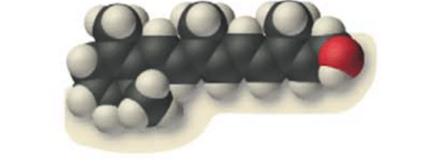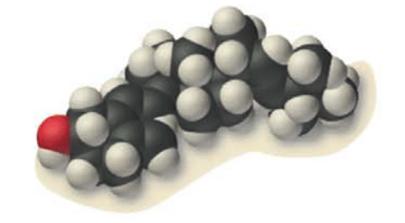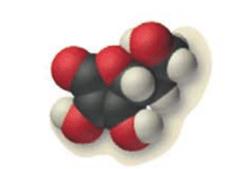
Chemistry In Focus
6th Edition
ISBN: 9781305544727
Author: Tro
Publisher: Cengage
expand_more
expand_more
format_list_bulleted
Textbook Question
Chapter 18, Problem 76E
Space-filling diagrams for the structures of vitamin A, vitamin D, and vitamin C are shown below. Which are fat soluble? Which are water soluble? What is the difference between the structures of water-soluble and fat-soluble vitamins?



Expert Solution & Answer
Want to see the full answer?
Check out a sample textbook solution
Students have asked these similar questions
Don't used hand raiting
A DEPT NMR spectrum is shown for a
molecule with the molecular formula of
C5H12O. Draw the structure that best
fits this data.
200
180
160
140
120
100
一盆
00
40
8-
20
ppm
0
Q
Don't used hand raiting
Chapter 18 Solutions
Chemistry In Focus
Ch. 18 - Prob. 1SCCh. 18 - Prob. 2SCCh. 18 - Prob. 3SCCh. 18 - Prob. 4SCCh. 18 - Prob. 18.1YTCh. 18 - Prob. 18.2YTCh. 18 - Prob. 1ECh. 18 - Prob. 2ECh. 18 - Prob. 3ECh. 18 - Prob. 4E
Ch. 18 - Prob. 5ECh. 18 - Prob. 6ECh. 18 - Prob. 7ECh. 18 - Prob. 8ECh. 18 - Prob. 9ECh. 18 - Prob. 10ECh. 18 - Prob. 11ECh. 18 - What are proteins, and what functions do they...Ch. 18 - Prob. 13ECh. 18 - Prob. 14ECh. 18 - Prob. 15ECh. 18 - Prob. 16ECh. 18 - Prob. 17ECh. 18 - Prob. 18ECh. 18 - Prob. 19ECh. 18 - Prob. 20ECh. 18 - Prob. 21ECh. 18 - Prob. 22ECh. 18 - Prob. 23ECh. 18 - What is basal metabolism? How much energy does it...Ch. 18 - Prob. 25ECh. 18 - Prob. 26ECh. 18 - Prob. 27ECh. 18 - For each of the fat-soluble vitamins, explain its...Ch. 18 - What is the role of vitamin C in the body? What...Ch. 18 - Prob. 30ECh. 18 - Prob. 31ECh. 18 - Prob. 32ECh. 18 - Prob. 33ECh. 18 - Prob. 34ECh. 18 - Prob. 35ECh. 18 - Prob. 36ECh. 18 - Prob. 37ECh. 18 - Prob. 38ECh. 18 - Prob. 39ECh. 18 - Prob. 40ECh. 18 - Prob. 41ECh. 18 - Prob. 42ECh. 18 - Prob. 43ECh. 18 - Prob. 44ECh. 18 - Prob. 45ECh. 18 - Prob. 46ECh. 18 - Prob. 47ECh. 18 - Prob. 48ECh. 18 - Prob. 49ECh. 18 - Prob. 50ECh. 18 - Prob. 51ECh. 18 - Prob. 52ECh. 18 - Prob. 53ECh. 18 - What is Agent Orange? How was it used? Why was its...Ch. 18 - Prob. 55ECh. 18 - Prob. 56ECh. 18 - Prob. 57ECh. 18 - Prob. 58ECh. 18 - Prob. 59ECh. 18 - Prob. 60ECh. 18 - Prob. 61ECh. 18 - Prob. 62ECh. 18 - Prob. 63ECh. 18 - Prob. 64ECh. 18 - Prob. 65ECh. 18 - Prob. 66ECh. 18 - Prob. 67ECh. 18 - Prob. 68ECh. 18 - Prob. 69ECh. 18 - Prob. 70ECh. 18 - Prob. 71ECh. 18 - Prob. 72ECh. 18 - Prob. 73ECh. 18 - Prob. 74ECh. 18 - Prob. 75ECh. 18 - 76. Space-filling diagrams for the structures of...
Knowledge Booster
Learn more about
Need a deep-dive on the concept behind this application? Look no further. Learn more about this topic, chemistry and related others by exploring similar questions and additional content below.Similar questions
- Shown below is the major resonance structure for a molecule. Draw the second best resonance structure of the molecule. Include all non-zero formal charges. H. H. +N=C H H H Cl: Click and drag to start drawing a structure. : ? g B S olo Ar B Karrow_forwardDon't used hand raitingarrow_forwardS Shown below is the major resonance structure for a molecule. Draw the second best resonance structure of the molecule. Include all non-zero formal charges. H H = HIN: H C. :0 H /\ H H Click and drag to start drawing a structure. ×arrow_forward
- Part II. two unbranched ketone have molecular formulla (C8H100). El-ms showed that both of them have a molecular ion peak at m/2 =128. However ketone (A) has a fragment peak at m/2 = 99 and 72 while ketone (B) snowed a fragment peak at m/2 = 113 and 58. 9) Propose the most plausible structures for both ketones b) Explain how you arrived at your conclusion by drawing the Structures of the distinguishing fragments for each ketone, including their fragmentation mechanisms.arrow_forwardPart V. Draw the structure of compound tecla using the IR spectrum Cobtained from the compound in KBr pellet) and the mass spectrum as shown below. The mass spectrum of compound Tesla showed strong mt peak at 71. TRANSMITTANCE LOD Relative Intensity 100 MS-NW-1539 40 20 80 T 44 55 10 15 20 25 30 35 40 45 50 55 60 65 70 75 m/z D 4000 3000 2000 1500 1000 500 HAVENUMBERI-11arrow_forwardTechnetium is the first element in the periodic chart that does not have any stable isotopes. Technetium-99m is an especially interesting and valuable isotope as it emits a gamma ray with a half life ideally suited for medical tests. It would seem that the decay of technetium should fit the treatment above with the result In(c/c) = -kt. The table below includes data from the two sites: http://dailymed.nlm.nih.gov/dailymed/druginfo.cfm?id=7130 http://wiki.medpedia.com/Clinical: Neutrospec_(Technetium_(99m Tc)_fanolesomab). a. b. C. Graph the fraction (c/c.) on the vertical axis versus the time on the horizontal axis. Also graph In(c/c.) on the vertical axis versus time on the horizontal axis. When half of the original amount of starting material has hours fraction remaining disappeared, c/c = ½ and the equation In(c/c.) = -kt becomes In(0.5) = -kt1/2 where t₁₂ is the half life (the time for half of the material to decay away). Determine the slope of your In(c/c.) vs t graph and…arrow_forward
- Please correct answer and don't use hand ratingarrow_forward1. a) Assuming that an atom of arsenic has hydrogen-like atomic orbitals, sketch the radial probability plots for 4p and 4d orbitals of S atom. Indicate angular and radial nodes in these orbitals. (4 points) b) Calculate Zeff experienced by and electron in 4p AO's in a arsenic atom. Use Slater rules that were discussed in lecture. (3 points)arrow_forwardNonearrow_forward
arrow_back_ios
SEE MORE QUESTIONS
arrow_forward_ios
Recommended textbooks for you
 Chemistry for Today: General, Organic, and Bioche...ChemistryISBN:9781305960060Author:Spencer L. Seager, Michael R. Slabaugh, Maren S. HansenPublisher:Cengage LearningChemistry: Matter and ChangeChemistryISBN:9780078746376Author:Dinah Zike, Laurel Dingrando, Nicholas Hainen, Cheryl WistromPublisher:Glencoe/McGraw-Hill School Pub Co
Chemistry for Today: General, Organic, and Bioche...ChemistryISBN:9781305960060Author:Spencer L. Seager, Michael R. Slabaugh, Maren S. HansenPublisher:Cengage LearningChemistry: Matter and ChangeChemistryISBN:9780078746376Author:Dinah Zike, Laurel Dingrando, Nicholas Hainen, Cheryl WistromPublisher:Glencoe/McGraw-Hill School Pub Co Introduction to General, Organic and BiochemistryChemistryISBN:9781285869759Author:Frederick A. Bettelheim, William H. Brown, Mary K. Campbell, Shawn O. Farrell, Omar TorresPublisher:Cengage Learning
Introduction to General, Organic and BiochemistryChemistryISBN:9781285869759Author:Frederick A. Bettelheim, William H. Brown, Mary K. Campbell, Shawn O. Farrell, Omar TorresPublisher:Cengage Learning Introductory Chemistry: An Active Learning Approa...ChemistryISBN:9781305079250Author:Mark S. Cracolice, Ed PetersPublisher:Cengage Learning
Introductory Chemistry: An Active Learning Approa...ChemistryISBN:9781305079250Author:Mark S. Cracolice, Ed PetersPublisher:Cengage Learning General, Organic, and Biological ChemistryChemistryISBN:9781285853918Author:H. Stephen StokerPublisher:Cengage Learning
General, Organic, and Biological ChemistryChemistryISBN:9781285853918Author:H. Stephen StokerPublisher:Cengage Learning Organic And Biological ChemistryChemistryISBN:9781305081079Author:STOKER, H. Stephen (howard Stephen)Publisher:Cengage Learning,
Organic And Biological ChemistryChemistryISBN:9781305081079Author:STOKER, H. Stephen (howard Stephen)Publisher:Cengage Learning,

Chemistry for Today: General, Organic, and Bioche...
Chemistry
ISBN:9781305960060
Author:Spencer L. Seager, Michael R. Slabaugh, Maren S. Hansen
Publisher:Cengage Learning

Chemistry: Matter and Change
Chemistry
ISBN:9780078746376
Author:Dinah Zike, Laurel Dingrando, Nicholas Hainen, Cheryl Wistrom
Publisher:Glencoe/McGraw-Hill School Pub Co

Introduction to General, Organic and Biochemistry
Chemistry
ISBN:9781285869759
Author:Frederick A. Bettelheim, William H. Brown, Mary K. Campbell, Shawn O. Farrell, Omar Torres
Publisher:Cengage Learning

Introductory Chemistry: An Active Learning Approa...
Chemistry
ISBN:9781305079250
Author:Mark S. Cracolice, Ed Peters
Publisher:Cengage Learning

General, Organic, and Biological Chemistry
Chemistry
ISBN:9781285853918
Author:H. Stephen Stoker
Publisher:Cengage Learning

Organic And Biological Chemistry
Chemistry
ISBN:9781305081079
Author:STOKER, H. Stephen (howard Stephen)
Publisher:Cengage Learning,
07 Physical Properties of Organic Compounds; Author: Mindset;https://www.youtube.com/watch?v=UjlSgwq4w6U;License: Standard YouTube License, CC-BY